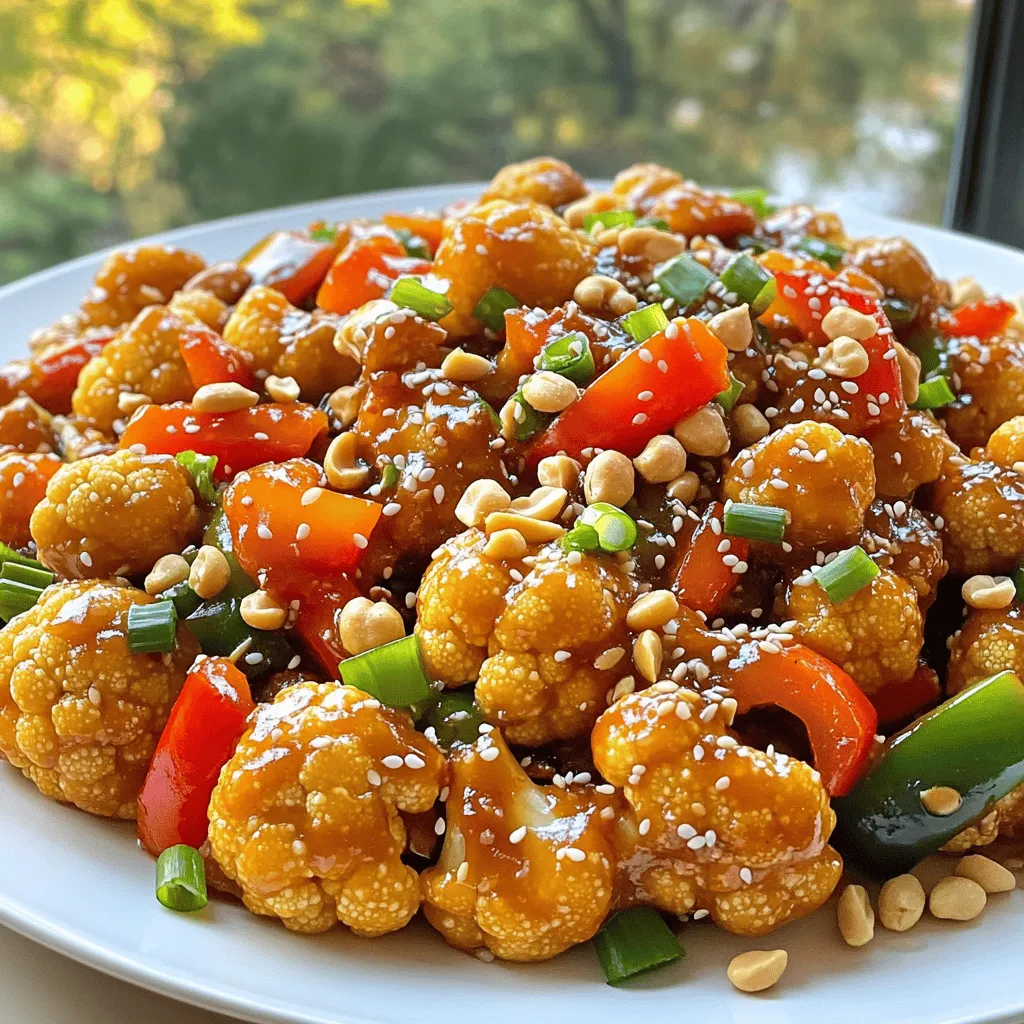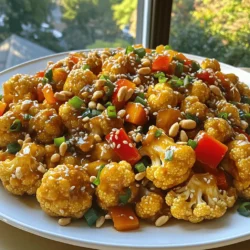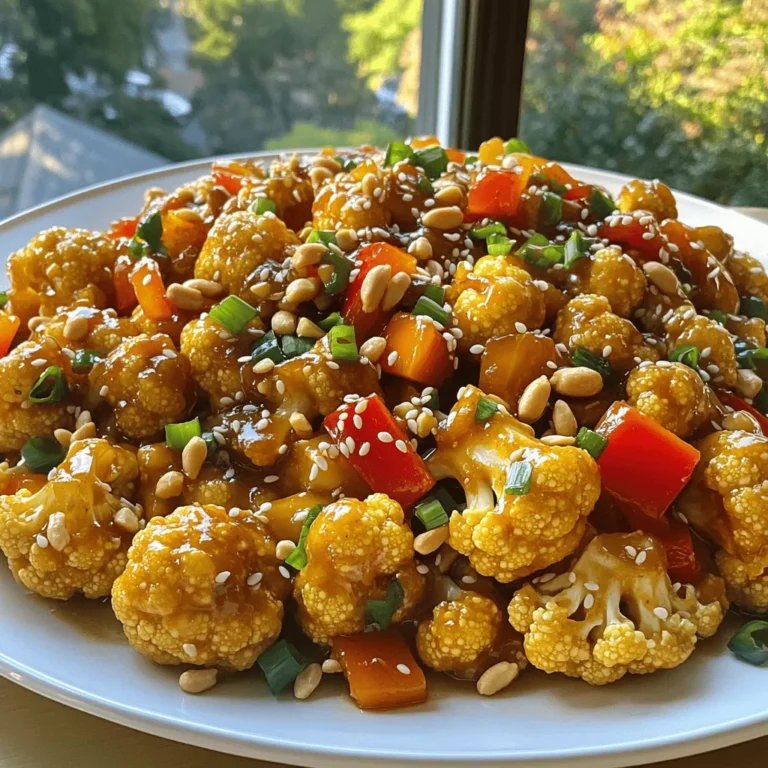Are you tired of bland takeout options? Let’s spice things up! My Better-Than-Takeout Kung Pao Cauliflower is a game-changer. This dish offers all the bold, vibrant flavors you love, but it’s packed with fresh veggies. I’ll walk you through easy steps, ingredient swaps, and tips to make it just right. Get ready to impress your taste buds and ditch the delivery menu for good!
Ingredients
List of Ingredients
– 1 medium head of cauliflower, cut into bite-sized florets
– 1 tablespoon cornstarch
– 2 tablespoons vegetable oil, divided
– 1 bell pepper (red or yellow), diced into small pieces
– 1/2 cup unsalted roasted peanuts
– 3 green onions, sliced thinly
– 2 cloves garlic, minced
– 1 tablespoon fresh ginger, minced
– 1/4 cup soy sauce (low sodium is preferred for a healthier option)
– 2 tablespoons rice vinegar
– 1 tablespoon hoisin sauce
– 1 tablespoon sugar (can be adjusted for sweetness)
– 1 teaspoon sesame oil for depth of flavor
– 1-2 teaspoons red pepper flakes (adjust according to your heat preference)
– Salt to taste
Ingredient Substitutions
You can swap cauliflower for broccoli if you prefer. For a nut-free option, use sunflower seeds instead of peanuts. If you want a gluten-free dish, choose tamari instead of soy sauce. For sweetness, you can try maple syrup or agave nectar in place of sugar.
Tips for Choosing Fresh Produce
When picking cauliflower, look for firm heads without dark spots. The florets should be tight and white. For bell peppers, choose ones that feel heavy and have smooth skin. Bright colors often mean they are fresh. Always check for soft spots, which can signal spoilage.
Step-by-Step Instructions
Preparation Steps
To start, grab a medium head of cauliflower. Cut it into bite-sized florets. Next, place the florets in a large mixing bowl. Sprinkle 1 tablespoon of cornstarch over the cauliflower. Toss gently until each piece is coated. This step helps the cauliflower get crispy when cooked.
Cooking Process
Heat 1 tablespoon of vegetable oil in a large skillet or wok over medium-high heat. When the oil shines, add the coated cauliflower. Stir-fry for 5 to 7 minutes. You want them golden brown and crispy. Once done, remove the cauliflower and set it aside.
In the same skillet, add another tablespoon of vegetable oil. Toss in the diced bell pepper. Stir-fry for 2 to 3 minutes, until it softens and brightens. Then, add the minced garlic and ginger. Stir for about 30 seconds. You want that lovely aroma without burning them.
Next, mix the sauce. In a small bowl, whisk together 1/4 cup soy sauce, 2 tablespoons rice vinegar, 1 tablespoon hoisin sauce, 1 tablespoon sugar, 1 teaspoon sesame oil, and 1 to 2 teaspoons red pepper flakes. Pour this sauce into the skillet over the bell peppers. Stir well, then add the crispy cauliflower back in. Toss everything together until coated.
Final Touches
Now, gently fold in 1/2 cup of roasted peanuts and 3 sliced green onions. Cook for 2 more minutes. This warms everything and blends the flavors. Taste the dish and add salt if needed. Remember, the soy sauce already adds some saltiness.
Serve your Kung Pao Cauliflower hot over fluffy cooked rice or quinoa. Enjoy the colorful dish topped with more green onions and a sprinkle of sesame seeds for a beautiful finish.
Tips & Tricks
How to Achieve Perfect Crispness
To get your cauliflower nice and crispy, start with cornstarch. Coat the florets evenly. This helps them turn golden brown when you fry them. Use high heat in your skillet or wok. The oil should shimmer before adding the cauliflower. Stir-fry until they are crispy. This usually takes about 5-7 minutes. Don’t overcrowd the pan; fry in batches if needed. This way, you can achieve that perfect crunch.
Adjusting Spice Levels
Want more heat? Add more red pepper flakes! Start with 1 teaspoon if you like mild spice. You can always add more later. Taste your dish after cooking. If it’s too spicy, balance it with sugar or extra soy sauce. For a milder flavor, skip the flakes entirely or use just a pinch. This way, everyone can enjoy the dish at their own heat level.
Enhancing Flavor Profiles
To deepen the flavor, use fresh garlic and ginger. They make a big difference! Adding sesame oil gives a nice nutty taste. You can also experiment with hoisin sauce. It adds sweetness and richness. If you want a tangy kick, try adding a bit more rice vinegar. Each of these tweaks helps you create a Kung Pao Cauliflower that suits your taste perfectly. Enjoy the process and make it your own!

Variations
Different Protein Additions
You can add protein to this dish for more nutrition. Chicken, shrimp, or tofu work great. For chicken, use bite-sized pieces and stir-fry until cooked. For shrimp, add them when you sauté the bell peppers. Tofu should be pressed, cubed, and sautéed until golden. All options blend well with the sauce and flavors.
Vegetarian/Vegan Alternatives
This recipe is already vegetarian, but you can make it vegan. Simply use tofu instead of any meat. Choose a vegan hoisin sauce since some brands use animal products. This keeps the dish tasty while meeting vegan needs. You can also add extra veggies like snow peas or carrots for more color and crunch.
Flavor Variations with Sauces
Feel free to play with the sauces to change the taste. You can swap soy sauce with tamari for a gluten-free version. Adding chili garlic sauce can kick up the heat. For a sweet twist, include pineapple juice in the sauce. Each option offers a new layer of flavor, making this dish exciting every time!
Storage Info
How to Store Leftovers
To keep your Kung Pao Cauliflower fresh, let it cool down first. Then, place it in an airtight container. This will help seal in flavors and moisture. Store it in the fridge for up to three days. If you plan to enjoy it later, don’t forget to label the container with the date.
Reheating Instructions
Reheating is easy! You can use a microwave or a skillet. If using a microwave, heat it in 30-second intervals until warm. Stir it gently to ensure even heating. For the skillet, add a splash of water and cover it. Heat over low heat until warm. This keeps the cauliflower from getting too soft.
Freezing for Later Use
You can freeze Kung Pao Cauliflower if you want to save some for later. Make sure to store it in a freezer-safe container. It will last up to two months. When ready to eat, thaw it in the fridge overnight. Reheat it in a skillet for the best taste and texture.
FAQs
Can I make Kung Pao Cauliflower ahead of time?
Yes, you can make Kung Pao Cauliflower ahead of time. Cook the dish and let it cool. Store it in an airtight container in the fridge. It stays fresh for up to three days. When ready to eat, reheat it in a pan on low heat. You can also microwave it, but the pan keeps it crisp.
What can I serve with Kung Pao Cauliflower?
Kung Pao Cauliflower pairs well with many sides. Here are some great options:
– Fluffy white rice
– Brown rice for a healthier choice
– Quinoa for added protein
– Stir-fried vegetables for more color and taste
– A simple salad with a light dressing
These sides balance the flavors and textures of the dish.
How do I make this dish gluten-free?
To make Kung Pao Cauliflower gluten-free, swap the soy sauce for gluten-free tamari. This change keeps the taste but removes gluten. Ensure the hoisin sauce you use is also gluten-free. Check the labels to be sure. This way, everyone can enjoy this tasty dish!
This blog covers the key steps for making Kung Pao Cauliflower. We discussed the fresh ingredients needed and tips for picking the best produce. You learned how to prepare and cook your dish, plus ways to add your personal touch. We also talked about storing leftovers and answered common questions.
Now you can make a delicious Kung Pao Cauliflower your way. Enjoy the process and have fun cooking!


